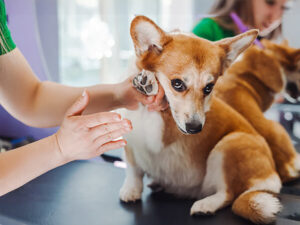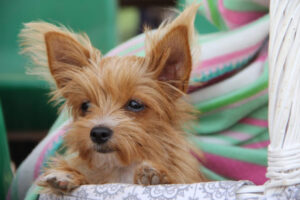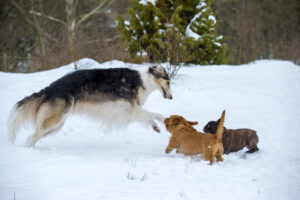Anyone who has ever owned a dog knows that no two dogs are alike. Their temperaments, behaviors, and personalities fall on a spectrum just like with humans. This comes into play with grooming, too. Some dogs find grooming to be a relaxing and even fun experience. Others find it very stressful. This can be exacerbated by the natural tendencies of your pet, such as if they are averse to strangers, being left alone/without you, being touched, and so on. It can be hard enough to groom your dog on your own in your own bathroom or sink at home, but a dog who is already anxious, stressed, and looking for the exit can be almost impossible to take to a groomer. Keeping calm during grooming is a struggle for many dogs.
At the same time, visiting a groomer is designed to help your pet stay healthy, look and feel good, and live life to the fullest. Multiple complications, such as matted hair, skin infections, ear infections, painful nails and paws from lack of trimming, and related problems can develop if your pet isn’t properly groomed periodically. Often, these complications aren’t easy to treat at home, and may require an expert’s touch. That means it’s very important to acclimate your dog to a professional groomer, either at their shop, or through a mobile grooming service.
The good news is there are strategies, techniques, and approaches that you can take with your pet to make them calmer and more at ease before, during, and after a grooming session. Some of these can be integrated with a willing groomer into the grooming routine itself, whereas others are things you can do with your pet on a 1-on-1 basis. Learn more from our experts about how to help your pet stay calm during grooming sessions.
Explore the Grooming Equipment to Keep Your Dog Calm During Grooming
If you’ve ever been to a dentist or doctor’s office, especially as a young child, you’ll be able to relate to the fear and anxiety that can be created in your pet by the unfamiliar grooming equipment they may encounter. Familiarity is one of the best ways to set your dog at ease, in any situation or environment. Familiarizing your pet with the grooming equipment you use on them at home, as well as the equipment present at your chosen groomer, is one of the easiest ways to reduce their stress level and help them get and stay calm during grooming.
Explore and Investigate
Most experts suggest letting your dog investigate, sniff, lick, and otherwise explore the combs, clippers, and other grooming implements to be used on them. This is, of course, easier with your own equipment at home, but most good groomers are willing to take time to let your dog get used to their service or shop, especially for a first-time visit. It can decrease the tension and stress level, and really make a difference in helping your dog stay calm during grooming.
Lightly Introduce Noise and Motion Tools
Certain grooming equipment can be fear-inducing, such as dog dryers, and especially in dogs that already have fears or issues with loud noises, for example. Using a hair dryer around them (not on them unless it’s on the lowest setting) at home is a good way to get them used to the sounds and sensations of a dog dryer. The same holds true with hair clippers. If your dog can experience the buzzing and vibration, without them being in use on your pet, and get used to it – perhaps with gentle touches against their legs or side – then they are far more likely to be calm instead of startled when it comes time to trim their hair.
ALSO READ – Everything You Need to Know About Dog Shaving
Always Have Treats to Distract, Reward, and Help Stay Calm During Grooming
As always, it’s useful to have some of your pet’s favorite treats on hand to reward them for good behavior, and to help them remain calm or focused on something more pleasant. You can work in one of many varieties of dog calming treats that are available from pet stores and online, with mild calming ingredients to help reduce stress and mellow out your pet. Be sure to read the instructions and avoid giving your pet too many for their size or in too short a period of time.
Start Small with Bathing and Related Tasks
It’s often said that cats hate water, and this is largely true. While dogs don’t have such an aversion, baths or bathing can be just as much of a problem for them as they are for cats. But it’s absolutely essential that your dog is bathed regularly, and you need to get them to at least tolerate bathing, even if they don’t end up enjoying it. As with our above advice, some treats and calming treats can be useful for a nervous, stressed, or anxious dog who resists baths. Really, the best advice for bathing, though, is to start small and take baby steps towards a full-on bath, so that your dog can get used to the idea. That’s often the best approach to more intimidating tasks, and can help build up a tolerance and familiarity with your dog, which will, quite naturally, help them remain calm during grooming and specifically bathing in the future.
Preparing a Bath
To start, you might want to put a towel or mat in the bathtub (so that your pet won’t slip on the slick surface). The first time, you may just want to spray them a bit with water from the handheld shower spray attachment, or pour a bit of water over their back or legs with a cup. Always be sure the water is a proper temperature – lukewarm, just above room temperature – to avoid scalding or burning them, or irritating their skin.
Making Progress
Either during the same bathing attempt, or a later session, you can move your way up to wet other areas of their body, introduce shampoo, and rinse them off. Giving your pet time to realize what you are doing, so they won’t be startled, and to get used to the process, is one of the best ways to reduce the stress that grooming can cause. Calming shampoos with pleasant, dog-friendly scents can also be a bonus element to help them get used to bathing.
Start Early in Your Pup’s Life
Perhaps no piece of advice for keeping your dog calm during grooming is more important than this: start early! We don’t mean early in the day, or showing up for an appointment early (though that’s always a good idea). Rather, start grooming in your home and at a salon or with a mobile groomer as early as possible in your pup’s life. When dogs are young, they are much more open to new experiences, sensations, and people. Early exposure creates familiarity when they are not so averse to new things, and therefore will make it more likely they remain calm and perhaps even enjoy grooming sessions later on in life.
What about Older Pets?
For older pets who may be visiting a grooming shop for the first time, communication with the groomer is key. They should know your pet is older, and it’s their first time visiting any kind of grooming shop. You should also let them know that your dog is nervous or stressed, or if they have any particular behaviors that they typically exhibit in that state – biting, sheltering of certain body parts, attempting to run away or jump away, etc. Good groomers will likely want to take some time just to meet your dog and allow them to get to know each other before attempting any grooming activities.
Other Tips for Nervous Dogs to Stay Calm During Grooming
In the worst case scenarios, where your dog is totally uncooperative and freaked out about going to the groomers, you can make a few trips and stop by just for a treat from your chosen groomer, staff, or even yourself. This will help your dog to create a positive association (rather than a negative one) with the groomer. Over time, with a solid relationship between dog and groomer, the stress or anxiety levels should decrease, making grooming much easier and less of a hassle for you and your pet.
Concluding Thoughts on Staying Calm During Grooming Activities
The bottom line is your pet needs regular grooming to look good, feel good, and stay healthy. It’s also not just about physical health, either. Just as you feel better and more “together”, energetic, and alive when you are fresh out of the shower and clean, so too does your dog feel better after they are clean and fresh. This is true even among dogs who hate the grooming process itself – if they’re not wriggling and running, ready to play, or having zoomies after their grooming, then we’ll eat our hats! A few treats after a grooming session, at home or with a professional groomer, won’t go awry either. At the very least, it will teach your pet that if they cooperate and get through the grooming itself, there are good rewards waiting for them!
ALSO READ – Expert Grooming Advice for Your Pet Pupper






